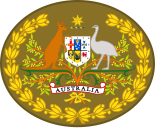A private is a soldier, usually with the lowest rank in many armies. Soldiers with the rank of private may be conscripts or they may be professional (career) soldiers.
Warrant officer (WO) is a rank or category of ranks in the armed forces of many countries. Depending on the country, service, or historical context, warrant officers are sometimes classified as the most junior of the commissioned officer ranks, the most senior of the non-commissioned officer (NCO) ranks, or in a separate category of their own. Warrant officer ranks are especially prominent in the militaries of Commonwealth nations and the United States.
Regimental sergeant major (RSM) is an appointment that may be held by a warrant officer (WO) in the British Army, the Royal Marines, and the armies of many other Commonwealth and former Commonwealth nations. It is also an actual rank in the Irish Defence Forces, and formerly in the British Army, Royal Marines and United States Army. Only one warrant officer holds the appointment of RSM in any regiment or battalion, making them the senior warrant officer; in a unit with more than one top-ranked WO, the RSM is considered to be first amongst equals". The RSM is primarily responsible for assisting their commander in maintaining standards and discipline amongst the non-commissioned members and acts as a parental figure to their subordinates, sometimes referred to by the mantra "Drill, Dress and Discipline".

A non-commissioned officer (NCO) is a military officer who does not hold a commission. Non-commissioned officers usually earn their position of authority by promotion through the enlisted ranks. In contrast, commissioned officers usually enter directly from a military academy, officer training corps (OTC) or reserve officer training corps (ROTC), or officer candidate school (OCS) or officer training school (OTS), after receiving a post-secondary degree.
Sergeant is a rank in use by the armed forces of many countries. It is also a police rank in some police services. The alternative spelling, serjeant, is used in The Rifles and other units that draw their heritage from the British light infantry. Its origin is the Latin serviens, 'one who serves', through the Old French term serjant.
Corporal is a military rank in use by the armed forces of many countries. It is also a police rank in some police services. The rank is usually the lowest ranking non-commissioned officer. In some militaries, the rank of corporal nominally corresponds to commanding a section or squad of soldiers.
Sergeant major is a senior non-commissioned rank or appointment in many militaries around the world.
Lance corporal is a military rank, used by many English-speaking armed forces worldwide, and also by some police forces and other uniformed organisations. It is below the rank of corporal.
Chief Warrant officer is a senior warrant officer rank, used in many countries.

"Other ranks" is the term used to refer to all ranks below officers in the British Army and the Royal Marines. It includes warrant officers, non-commissioned officers ("NCOs") and ordinary soldiers with the rank of private or regimental equivalent. Officers may, in speaking, distinguish themselves from those "in the ranks".
The South African National Defence Force's rank system is largely based on the British system, with the Air Force sharing the Army rank titles. Rank titles changed over time as did the insignia.
Before Unification as the Canadian Armed Forces in 1968, the Canadian military had three distinct services: the Royal Canadian Navy, the Royal Canadian Air Force, and the Canadian Army. All three services had a Regular (full-time) component and a reserve (part-time) component. The rank structure for these services were based on the services of the British military, the Royal Navy, the Royal Air Force, and the British Army. The change to a "Canadian" rank structure meant that many of the traditional (British) rank titles and insignia were removed or changed.

A bandmaster is the leader and conductor of a band, usually a concert band, military band, brass band or a marching band.
The Australian Defence Force's (ADF) ranks of officers and enlisted personnel in each of its three service branches of the Royal Australian Navy (RAN), the Australian Army, and the Royal Australian Air Force (RAAF) inherited their rank structures from their British counterparts. The insignia used to identify these ranks are also generally similar to those used in the British Armed Forces.

A warrant officer (WO) in the British Armed Forces is a member of the highest-ranking group of non-commissioned ranks, holding the King's Warrant, which is signed by the Secretary of State for Defence.

Regimental Sergeant Major of the Army (RSM-A) is the most senior Warrant Officer in the Australian Army. It is a singular appointment – it is only held by one person at any time. RSM-A holds the unique rank of Warrant Officer (WO) which is senior to Warrant Officer Class One. The special insignia for the RSM-A is the Australian coat of arms with a wreath around it. The twelfth and current Regimental Sergeant Major of the Army is Kim Felmingham.

The Corps Regimental Sergeant Major is the most senior warrant officer of the Royal Marines. Responsible for maintaining standards and discipline within the Royal Marines, they act as a parental figure to their subordinates and also to junior officers, even though the latter technically outrank the RSM.

The Army Sergeant Major is the most senior member of the other ranks of the British Army.














